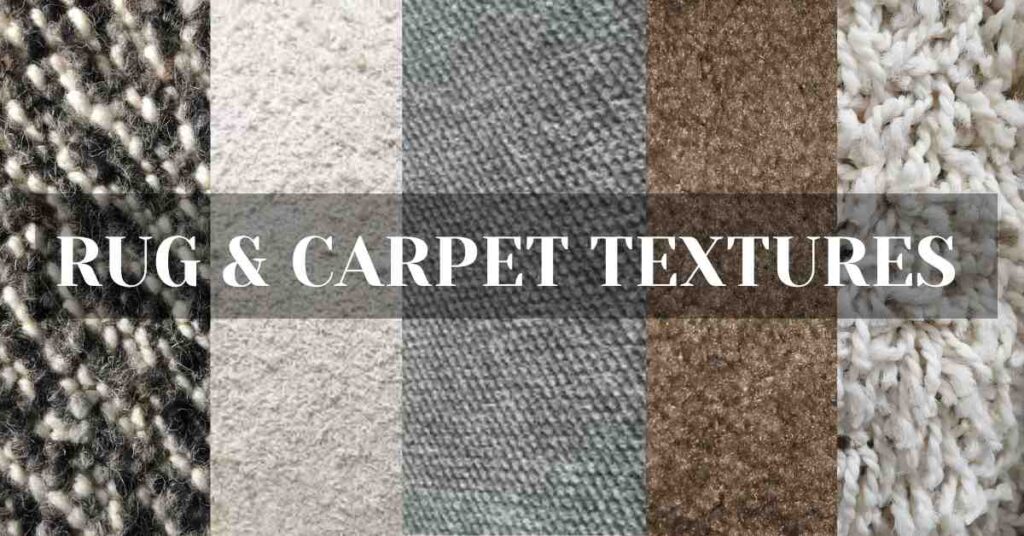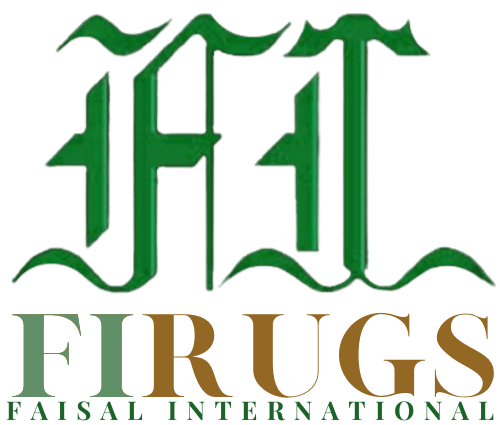
Table of Contents
Carpet Texture And Rug Texture Types
What Is Carpet Texture?
“Carpet texture” is the way the closeup of the carpet looks and feels. The rug texture formation is differentiable by their weaving techniques and other factors.
It is easy to understand about rug texture types by categorizing them in two different categories:
- Texture By Weave
- Texture By Feel And Appearance
Carpet Texture Pattern By Weave
When you decide you want a new rug for your home, it seems like an easy decision. However, not all rugs are the same, and when you decide on your home, the texture of the carpet you choose will impact your daily life.
When you consider the traffic you get and the spills or crashes you see, you may begin to realize the importance of knowing what each rug type brings to the table.
Here are some of the typical texture types you will find when shopping for rugs:
1. Cut Pile Texture
The cut pile rug provides a soft and smooth texture to your floor that will feel velvet under your feet and add elegance to any interior. Such a pattern forms when the yarn is cut to the same length on the carpet. Although generally less resistant to foot traffic, the wool/fiber is more tightly woven to withstand the test of time.
What Fibers
A cut pile carpet is the most common type of rug texture. There are a variety of materials used in which they are made. They can nearly be in most fiber types, including wool, jute, bamboo silk, viscose, polypropylene, nylon, polyester, coir, etc.
2. Loop Pile Texture
The looped pile rug is recognizable by its woolen look and looped surface, created by stitching the thread into the primary backing, leaving a loop. Berber carpet is a popular type of loop pile and is known for its strength in high-traffic areas.
Cleaning is effortless too, and the stack of loops hides fingerprints and vacuum marks well. However, with a pile of loops, you shouldn’t use vacuum brushes to cause abrasions and cut the delicate threads that make up the loop.
The loop pile is great for families and if you are looking to create a cozy atmosphere in your living space.
What Fibers
Loop pile textured carpets are generally low pile carpet. They can have fiber such as wool, silk, cotton, jute, hemp, and synthetics.
3. Cut And Loop Texture
In this modern rug texture, as the name suggests, the cut and loop rug incorporates both loop pile and cut pile textures, resulting in different patterns. The cut and loop weaving will give you excellent design flexibility, whether you want accent colors to spice up the areas, multi-color effects to hide dirt and stains, or just a bold color scheme.
That is not it, cut and loop pile texture can highlight specific designs and enhance the carpet’s overall look.
Cleaning cut and loop carpets take a little extra effort compared to cut pile carpets, but regular vacuuming eases the work.
What Fibers
This is a texture that can play with the distribution of different fibers across the entire carpet. The fiber for the loop pile and the fiber for the cut pile can either all be the same or different. For example, the loop pile in viscose and the cut pile in wool and vice versa.
4. Frieze Texture
The curly rug gives the plush feel of a cut pile rug but has the short pile twisted and rolled. Durability is not an issue with frieze, as it is recommended for areas of your home heavily used or subject to high traffic.
The versatility of frieze texture carpet is also very attractive. It can be applied in your kid’s room or informal bedrooms, creating variation in any space.
Pros And Cons Of Frieze Carpets
PROs
- Since frieze carpets do not fray or snag easily, they are durable carpets.
- Frieze carpets are resistant to stain and dirt, ideal for high traffic, and friendly with kids and pets.
- As frieze carpets are thicker, they are more sound-insulating.
- Frieze carpets come in a wide range of modern colors that make them the perfect addition to any room.
- As they are warmer than other less thick carpets, soft frieze carpets are suitable for cold regions.
CONs
- Frieze has a casual look, not ideal for formal space. Since they have a long pile, cleaning them can sometimes be challenging.
5. Saxony Texture
Saxony features long pile lengths and is quite soft, making it another cut loop carpet. In this more formal pattern, the piles are packed densely and twisted, so they stand straight. The height and uniformity of their direction causes them to quickly show tracking and footprints, which makes them ideal only for areas with very little traffic.
6. Shag - The Modern Carpet Texture
Shaggy carpets wouldn’t have made it into this category, but only if they were not unique to their making technique and looks. The shag carpet texture is interesting because of the look and comfort they carry with them.
Shag carpets are woven on horizontal looms and have a hairy appearance because of their longer cut piles. However, they are not a tileable carpet texture for the floor. So you won’t find carpet tiles in this texture.
7. Aubusson Persian Rug Texture
An Aubusson Persian carpet texture will differ greatly from the other plain texture Persian carpets of its category. In Aubusson, an interesting texture is created by a specialist hand carving, where the designs are carved after the whole rug weaving, washing, and trimming is complete. So a rug that has low and high pile texture is not always a loop and cut texture rug.
Carpet Texture By Feel And Appearance
8. Plush
The most popular style of carpet in homes is plush. Pile height is even and flat after the pile has been sheared. A plush texture carpet will show footprints and vacuum marks. A solid color of this style is usually available, but these days you can find plush styles in multi-tonnage.
9. Texture Carpet
Texture plush carpet, although very similar to a plush style carpet, but what makes this different is the uneven tuft heights. Vacuum marks and footprints are less visible when the tuft height varies.
Textured rugs mostly have multi-toned texture, but they are available in solid colors also. For busy families, it is an excellent carpet.
10. Soft
Often almost all rugs and carpets are soft. Other than other factors, softness in carpets is the prime factor why anyone would install them. Carpets specially constructed with good quality wool are smooth and soft.
These days, also synthetic fiber carpets such as polypropylene and nylon are also soft and replicate wool quite well.
11. Rough
Some fiber is not soft but rough in nature. A jute rug texture is rough and the rug feels nonsmooth. Some low-grade wool also has less softness. Some examples of such fabric carpets are those made in, low-quality wool, seagrass, sisal, coir, thick nylon, etc.
12. Velvish
Velvet texture is indeed the most comforting one to feel underfoot. They are for babies to crawl and pets and most suitable for the most luxurious areas of the house.
Silk made rugs such as bamboo silk, fine viscose and cashmere silk, rugs produce excellent velvet rug texture. Not to forget, even high-quality New Zealand wool rugs produce the same texture.
13. Abrash
Abrash texture pattern rugs are a unique texture that you can find in oriental rugs. Abrash can result from the type of the yarn, especially hand spun(of its twist and density) and the variations in the process of dyeing.
A rug’s abrash texture is the color striation that runs horizontally across its face. These color variations happen within the same color, for example, a dark blue field may have striations of lighter blue.
This is the texture that is created naturally in bamboo silk fiber rugs and natural dyed hand knotted carpets.
To get the striation texture in rugs, tie-dyeing is another smart technique to achieve the appearance. In this process of dyeing, the yarn is tied tightly and led to dye. Due to the tying, the dye reaches the yarn in different portions creating the abrash pattern.
Persian Gabbeh rug is another example of such rugs. They have dual/trio tone colors that look like tiny bulbs speaking across the rug’s surface.
FAQs
How is the carpet tiles texture?
Carpet tiles are mostly square and easily decorative, sometimes using light adhesive to stick flat to the floor. Therefore, carpet tile texture is often designed hard and thin and not much plush to feel underfoot. However, they are also available in plush texture in the market.
What is the difference between loop pile and cut pile texture rugs?
There are three carpet style finishing designs: loop pile texture, cut pile texture, and a blend of loop and cut-pile. The loops of a loop-pile carpet are never cut but left in their woven form.
In cut-piles, it’s the opposite. Here, the loops must be cut. Additionally, some carpets are woven in both the texture styles, cut-piles, and loop-piles within the piece.
How to choose the best carpet texture?
Consider the following to determine what texture of carpet is ideal for your space:
- Budget – Begin with the range of budget you are willing to put in to buy. While wool is expensive, a modern shaggy carpet in synthetics is much inexpensive.
- Location – Choose the carpet’s texture based on the amount of traffic it will receive. It will be for casual use at home or for more formal usage in the office, where there may be less walking traffic.
- Fiber – If durability is your prime target, never rule out wool made carpets.
- Pets – Berber carpets may not be suitable if having pets with claws around. Choosing a plush carpet would be most suitable for them.
